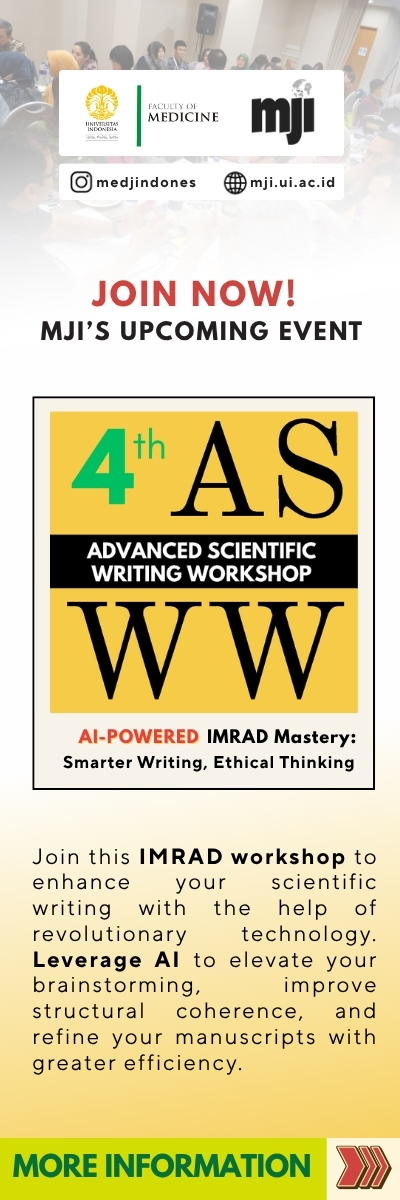The application of correction factors on serum retinol of Indonesia school children
DOI:
https://doi.org/10.13181/mji.v19i4.417Abstract
Aim: Vitamin A deficiency among children is still a public health problem in Indonesia. Serum/plasma retinol concentration is the best indicator in assessing vitamin A status. However, there is growing concern that infection/ inflammation lowers serum retinol concentration, thus creating potential misinterpretation of vitamin A status, which could affect policy makers in planning suitable nutrition programs targeted at community. The aim of this study was to highlight the importance of applying correction factors, to better interpret serum retinol as a nutritional status
biomarker.
Methods: A cross sectional study involving 54 apparently healthy school children was conducted in East Nusa Tenggara. Height, body weight, concentrations of serum retinol, CRP and AGP were assessed. Based on concentrations of serum CRP and AGP, four infl ammation groups were determined, namely reference, incubation, early convalescence and late convalescence groups. Correction factor was obtained by dividing serum retinol concentration of reference group by that of the other three groups. Correction factors were then used to correct serum retinol concentration without any influence of infection/ inflammation.
Results: The prevalence of stunting and underweight were 43% and 22% respectively, but there was no wasting among the school children. Applying correction factor lowered the prevalence of vitamin A defi ciency from 20.4% to 18.5%; thus changing vitamin A defi ciency from a severe public health problem to a moderate public health problem.
Conclusion: Correcting serum retinol concentration for the infl uence of infection reduced the apparent severity of vitamin A deficiency. This could affect policy for planning nutrition programs designed for communities. (Med J Indones 2010;Â 19:258-63)
Keywords: correction factor, infection, school children, serum retinol
Downloads
References
World Health Organization. Global prevalence of vitamin A defi ciency in populations at risk 1995-2005: WHO global database on vitamin A defi ciency, 2009. (cited 2010 April 10). Available from: http://whq libdoc.who.int/ publications/2009/9789241598019_eng.pdf
Sommer A, Davidson FR. Assessment and control of vitamin A defi ciency: the annecy accords. J Nutr 2002; 132:2845S-50S.
Thurnham DI, Mburu AS, Mwaniki DL, De Wagt A.Micronutrients in childhood and the infl uence of subclinical infl ammation. Proc Nutr Soc 2005;64:502-9.
Paracha PI, Jamil A, Northrop-Clewes CA, Thurnham DI. Interpretation of vitamin A status in apparently healthy Pakistani children by using markers of subclinical infection. Am J Clin Nutr 2000; 72:1164-9.
Stephensen CB, Gildengorin G. Serum retinol, the acute phase response, and the apparent misclassifi cation of vitamin A status in the third National Health and Nutrition Examination Survey. Am J Clin Nutr 2000; 72:1170-8.
Shankar AH, Genton B, Semba RA. Effect of supplementation of vitamin A on morbidity due to Plasmodium falciparum in young children in Papua New Guinea: a randomised trial. Lancet 1999; 354:201-9.
Filteau SM et al. Vitamin A supplementation, morbidity, serum acute-phase proteins in young Ghanaian childrens. Am J Clin Nutr 1995; 62:434-8.
Tomkins A. Assessing micronutrient status in the presence of infl ammtion. J Nutr 2003; 1649S - 55S.
Wieringa FT, Dijkhuizen MA, West CE, Northrop-Clewes CA, Muhilal. Estimation of the Effect of the Acute Phase Response on Indicators of Micronutrient Status in Indonesian Infants. J. Nutr. 2002; 132:3061-6.
Thurnham DI, McCabe GP, Northrop-Clewes CA, Nestel P. Effects of subclinical infection on plasma retinol concentrations and assessment of prevalence of vitamin A defi ciency: meta-analysis. Lancet 2003; 362:2052-8.
Fahmida U, Dillon DHS. Handbook of Nutritional Assessment. UI Press 2007.
World Health Organization. Growth Reference data for 5-19 years. AnthroPlus. (cited 2010 April 10). Available from: http://www.who.int/growthref/en/
World Health Organization. Nutrition Landscape Information System. WHO 2010. (cited 2010 October 10) Available from: www.who.int/nutrition/nlis_ interpretation_guide.pdf
Erhardt JG, Estes JE, Pfeiffer CM, Biesalski HK, Craft NE. Combined measurement of Ferritin, Soluble Transferrin Receptor, Retinol Binding Protein and C-Reactive Protein by Inexpensive, Sensitive, and Simple Sandwich Enzyme- Link Immunosorbent Assay Technique. J.Nutr 2004;134(11):3127-32.
Stephensen CB, Alvare JO, Kohatsu J, Hardmeier R, Kennedy Jr JI, Gammon Jr RB. Vitamin A is excreted in the urine during acute infection. Am J Clin Nutr 1994; 60:388-92.
Dillon DHS. Nutritional health of Indonesian adolescent girls: the role of riboflavin and vitamin A on iron status. PhD thesis. 2005.Wageningen University Cruickshank AM, Hansell DT, Burns HJG, Shenkin A. Effect of nutritional status on acute-phase protein response to elective surgery. Br J Surg 989;76(2):165-8.
Fleck, A and Myers M. Diagnostic and prognostic significance of the acute phase proteins. In: Gordon AH, Koj A, eds. The Acute Phase Response to Injury and Infection, Amsterdam: Elsevier, 1985: p.249-71.
Calvin J, et al. The relative merits of acute-phase response. Am Clin Biochem, 1988. 25: p.60-6.
Schweigert FJ. Infl ammation-induced changes in the nutritional biomarkers serum retinol and carotenoids. Current Opinion in Clinical Nutrition & Metabolic Care 2001; 4:477-81.
Downloads
Published
How to Cite
Issue
Section
License
Authors who publish with Medical Journal of Indonesia agree to the following terms:
- Authors retain copyright and grant Medical Journal of Indonesia right of first publication with the work simultaneously licensed under a Creative Commons Attribution-NonCommercial License that allows others to remix, adapt, build upon the work non-commercially with an acknowledgment of the work’s authorship and initial publication in Medical Journal of Indonesia.
- Authors are permitted to copy and redistribute the journal's published version of the work non-commercially (e.g., post it to an institutional repository or publish it in a book), with an acknowledgment of its initial publication in Medical Journal of Indonesia.





































